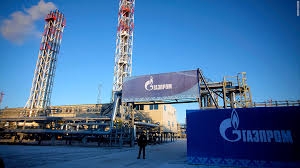Gazprom Share in Europe to Reach 40%
Old Europe is not as powerful as it once was. Where just ten years ago she could freely choose with whom from the energy supplier countries to conclude an agreement, and with whom not, with the beginning of the collapse of her own production, she lost such privileges. Under construction pipelines from Transcaucasia and Central Asia hardly satisfy her gas supply, but Russia will make the Old World "depend" on its gas "needle".
The share of Gazprom in the markets of Europe and Turkey in 2013 rose to 30.07%, while in 2012 it was 26%. This was a great achievement for Russia. The joy of the top manager of Russia's main gas company Alexander Miller was unlimited: before that, Europe had systematically pushed Russia out of its market, and now it seemed like the demand had begun again. Since then, Miller has had the opportunity to brighten his report with growing export figures. In 2015, the share had grown to 31%, and, last year, Miller said it was 34%. And in the next ten to fifteen years this figure looks likely to stay.
“The drop in production in European countries, together with the decrease in supplies from Africa, will continue to ensure the growth of the share of Russian gas in the EU market,” said Michael Stoppard, Managing Director of the consulting agency IHS Markit, during the National Oil and Gas Forum.
"Looking at the horizon of 2030, both Russian gas and LNG [liquefied natural gas] will significantly increase their market share as a result of declining production in Europe and supplies from some African countries," the agency said.
According to estimates of IHS Markit, the growth will be smooth, at 1% per year until 2020. By this time, Gazprom's share in Europe will reach 38%, but further growth will slow to 2% over the next 10 years. That is, in the end it will be 40%.
“Now we see an explosive interest in cheap Russian gas production from many Central European countries, leading us to believe that new resources, for example, from the shelf of Azerbaijan or Turkmenistan, are unlikely to reduce its market share," said Stoppard.
Thus, the share of "Caspian gas," from Azerbaijan and Turkmenistan, by 2020 will grow from the current 2% to about 8% of the market.
"On the other hand, there will be a growing competition between gas from Russia and LNG from the US and Australia, which will determine the world prices for gas," he added.
However, given the current prices on the EU gas market, the US LNG has very vague prospects in "future": too small a difference between the cost of liquefaction in the US and the sale price in Europe will not allow it to happen. Because of a lack of its own gas, its cost, in order to attract sellers, will grow, which will open up a European market for LNG, Stoppard claimed. In his opinion, for LNG penetration into Europe it will be enough if the difference between the cost of liquefaction and local prices reaches $4 per million British thermal units (now there is no such difference).
“As a result, by 2020, the share of LNG in the EU market will reach 15% (now 10%), and by 2030 - 20%, taking second place in supply after Gazprom,” the top manager of IHS Markit said.
LNG is very sensitive to price jumps in the market and loses at a cost price in comparison with Russian gas. But compared to gas from Africa, in many ways it is competitive: African gas requires a lot of investment, the situation with transportation security is even more acute, "says Chris Lafakis, an analyst with the oil and gas sector of Moody's Analytics. “Obviously, Russian supplies are not under threat of reduction, especially if we take into account the great interest in Germany and Austria, large sales markets”.
The real competitor to American gas is only gas from Turkmenistan, since with it Europe plans to enter into long-term contracts.
"In fact, these contracts are yet to be concluded, the pipe is incompleted, and the regasification terminals for LNG are unloaded; there are big doubts that the share of Asian gas will exceed LNG," Lafakis said.
Dimitri Dolaberidze











